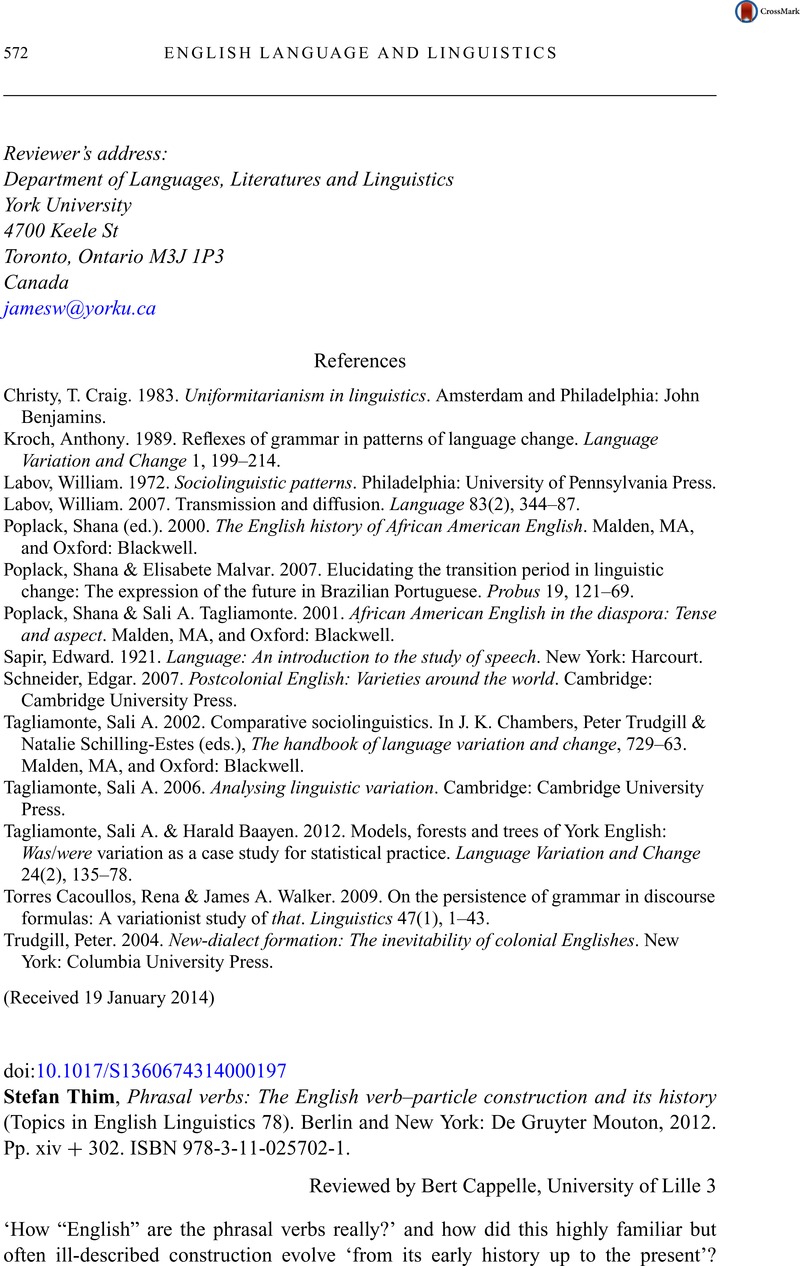No CrossRef data available.
Article contents
Stefan Thim, Phrasal verbs: The English verb–particle construction and its history (Topics in English Linguistics 78). Berlin and New York: De Gruyter Mouton, 2012. Pp. xiv + 302. ISBN 978-3-11-025702-1.
Published online by Cambridge University Press: 28 October 2014
Abstract
An abstract is not available for this content so a preview has been provided. Please use the Get access link above for information on how to access this content.

- Type
- Reviews
- Information
- Copyright
- Copyright © Cambridge University Press 2014
References
Biber, Douglas, Johansson, Stig, Leech, Geoffrey, Conrad, Susan & Finegan, Edward. 1999. Longman grammar of spoken and written English. London: Longman.Google Scholar
Bolinger, Dwight. 1971. The phrasal verb in English. Cambridge, MA: Harvard University Press.Google Scholar
Booij, Geert. 2002. Separable complex verbs in Dutch: A case of periphrastic word formation. In Dehé, Nicole, Jackendoff, Ray, McIntyre, Andrew & Urban, Silke (eds.), Verb–particle explorations, 21–41. Berlin and New York: Mouton de Gruyter.Google Scholar
Brinton, Laurel. 2013. Review of Stefan Thim. 2012. The phrasal verb and its history. Berlin and New York: Mouton de Gruyter. Language 89 (3), 664–67.Google Scholar
Cappelle, Bert. 2002. And up it rises: Particle preposing in English. In Dehé, Nicole, Jackendoff, Ray, McIntyre, Andrew & Urban, Silke (eds.), Verb–particle explorations, 43–66. Berlin and New York: Mouton de Gruyter.Google Scholar
Cappelle, Bert. 2006. Particle placement and the case for ‘allostructions’. Constructions. urn:nbn:de:0009-4-6839.Google Scholar
Cappelle, Bert. 2009. Contextual cues for particle placement: Multiplicity, motivation, modeling. In Bergs, Alexander & Diewald, Gabriele (eds.), Contexts and constructions, 145–92. Amsterdam and Philadelphia: John Benjamins.Google Scholar
Cappelle, Bert, Pulvermüller, Friedemann & Shtyrov, Yury. 2010. Heating up or cooling up the brain? MEG evidence that phrasal verbs are lexical units. Brain and Language 115 (3), 189–201.Google Scholar
Davies, Mark. 2004–. BYU-BNC. (Based on the British National Corpus from Oxford University Press). http://corpus.byu.edu/bnc/.Google Scholar
Davies, Mark. 2010. COHA. The Corpus of Historical American English: 400 million words, 1810–2009. http://corpus.byu.edu/coha/.Google Scholar
Davies, Mark. 2013. GLoWbE. Corpus of Global Web-Based English: 1.9 billion words from speakers in 20 countries. http://corpus2.byu.edu/glowbe/.Google Scholar
Den Dikken, Marcel. 2013. Review of Bettelou Los, Corrien Blom, Geert Booij, Marion Elenbaas & Ans van Kemenade. 2012. Morphosyntactic change: A comparative study of particles and prefixes. Journal of Linguistics 49(3), 703–09.Google Scholar
Elenbaas, Marion. 2007. The synchronic and diachronic syntax of the English verb–particle combination. Utrecht: LOT.Google Scholar
Farrell, Patrick. 2005. English verb–preposition constructions: Constituency and order. Language 81 (1), 96–137.Google Scholar
Goldberg, Adele E. To appear. Tuning in to the verb-particle construction in English. In Léa Nash & Pollet Samvelian (eds.) Syntax and semantics: Complex predicates.Google Scholar
Hoppermann, Christina. 2013. Review of Bettelou Los, Corrien Blom, Geert Booij, Marion Elenbaas & Ans van Kemenade. 2012. Morphosyntactic change: A comparative study of particles and prefixes. LINGUIST List http://linguistlist.org/pubs/reviews/get-review.cfm?subid=16690836.Google Scholar
Ishizaki, Yasuaki. 2012. A usage-based analysis of phrasal verbs in Early and Late Modern English. English Language and Linguistics 16 (2), 241–60.Google Scholar
Jackendoff, Ray. 2002. English particle constructions, the lexicon, and the autonomy of syntax. In Dehé, Nicole, Jackendoff, Ray, McIntyre, Andrew & Urban, Silke (eds.), Verb–particle explorations, 67–94. Berlin and New York: Mouton de Gruyter.Google Scholar
Kennedy, Arthur Garfield. 1920. The Modern English verb–adverb combination. Palo Alto: Stanford University Press.Google Scholar
Lin, Yuri, Michel, Jean-Baptiste, Aiden, Erez Lieberman, Orwant, Jon, Brockman, William & Petrov, Slav. 2012. Syntactic annotations for the Google Books Ngram Corpus. Proceedings of the 50th Annual Meeting of the Association for Computational Linguistics, vol. 2: Demo Papers (ACL '12), 169–74. Stroudsburg, PA: Association for Computational Linguistics.Google Scholar
Lohse, Barbara, Hawkins, John A. & Wasow, Thomas. 2004. Domain minimization in English verb–particle constructions. Language 30 (2), 328–61.Google Scholar
Los, Bettelou, Blom, Corrien, Booij, Geert, Elenbaas, Marion & van Kemenade, Ans. 2012. Morphosyntactic change: A comparative study of particles and prefixes. Cambridge: Cambridge University Press.Google Scholar
Martin, Pamela. 1990. The phrasal verb: Diachronic development in Bitish and American English. PhD thesis, Columbia University New York.Google Scholar
McIntyre, Andrew. 2002. Idiosyncrasy in particle verbs. In Dehé, Nicole, Jackendoff, Ray, McIntyre, Andrew & Urban, Silke (eds.), Verb–particle explorations, 95–118. Berlin and New York: Mouton de Gruyter.Google Scholar
McIntyre, Andrew. 2007. Particle verbs and argument structure. Language and Linguistics Compass 1 (4), 350–67.Google Scholar
Michel, Jean-Baptiste, Shen, Yuan Kui, Aiden, Aviva Presser, Veres, Adrian, Gray, Matthew K., Brockman, William, The Google Books Team, Joseph P. Pickett, Dale Hoiberg, Dan Clancy, Peter Norvig, Jon Orwant, Steven Pinker, Martin A. Nowak & Erez Lieberman Aiden. Quantitative analysis of culture using millions of digitized books. Science 331 (6014), 176–82.Google Scholar
OED. Oxford English Dictionary, 2nd edition, 1989. Online version, December 2013 update. https://stuiterproxy.kuleuven.be/,DanaInfo=www.oed.com+;, accessed 26 January 2014.Google Scholar
Rodríguez-Puente, Paula. 2013. The development of phrasal verbs in British English from 1650 to 1990: A corpus-based study. PhD thesis. Universidade de Santiago de Compostela.Google Scholar
Traugott, Elizabeth Closs. 1991. Review of Laurel J. Brinton. 1988. The development of English aspectual systems: Aspectualizers and post-verbal particles. Studies in Language 15 (1), 221–26.Google Scholar
Traugott, Elizabeth Closs. 1999. A historical overview of complex predicate types. In Brinton, Laurel J. & Akimoto, Minoji (eds.), Collocational and idiomatic aspects of composite predicates in the history of English, 239–60. Amsterdam and Philadelphia: John Benjamins.CrossRefGoogle Scholar
Wild, Catherine. 2010. Attitudes towards English usage in the late modern period: the case of phrasal verbs. PhD thesis, University of Glasgow.Google Scholar


